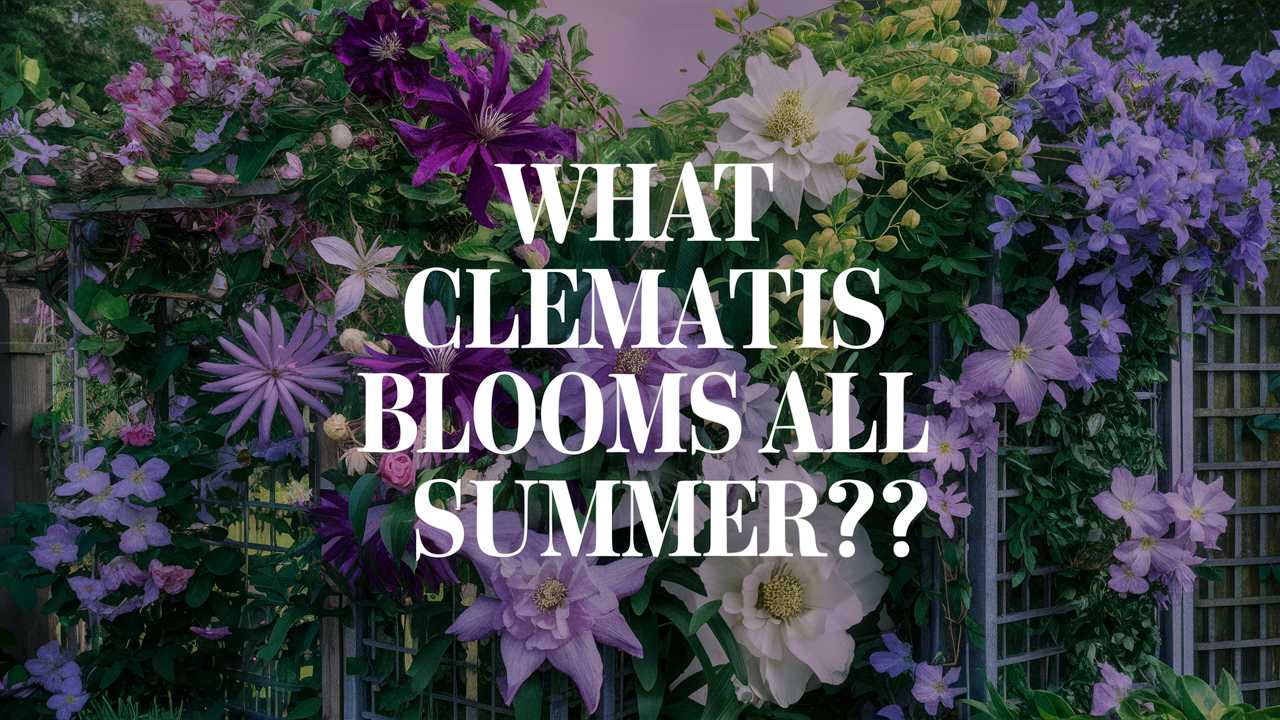Clematis is a stunning perennial vine known for its breathtaking flowers and versatility in the garden. While many varieties produce blooms primarily in spring, certain types of clematis offer ear-to-ear blossoms all summer long. In this post, we’ll explore which clematis are best for summer bloom, how to cultivate and care for them, and creative ideas for incorporating them into your garden design.
Understanding Clematis Varieties

Clematis is a genus that encompasses a wide range of species, each with its own flowering schedule and characteristics. Broadly speaking, clematis can be categorized into three main groups based on their blooming times:
Early Blooming: These varieties typically flower in late spring and early summer.
Mid-Season Blooming: These plants bloom in summer and can sometimes provide a second flush of flowers in the fall.
Late Blooming: This group consists of clematis that produce blossoms in late summer and continue blooming into autumn.
To enjoy a summer filled with stunning blooms, focusing on mid-season and late-blooming varieties is essential.
Mid-Season Bloomers: Clemmatis That Start in Late Spring and Carry Into Summer
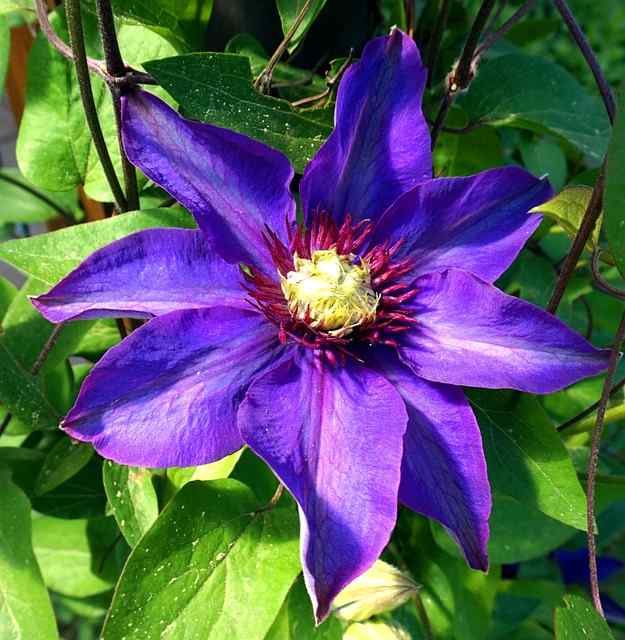
1. Clematis ‘Jackmanii’
Overview: ‘Jackmanii’ is a classic choice among gardeners due to its vigorous growth and large, deep purple flowers. It typically begins to bloom in mid-spring and continues well into summer.
Characteristics: This variety showcases bold, 6-8 inch star-shaped flowers that are a favorite for trellises, arbors, and fences. The foliage is equally attractive, featuring lush green leaves that serve as a beautiful backdrop to the larger-than-life blooms.
Care Tips: To keep ‘Jackmanii’ healthy, ensure it receives well-drained soil, regular watering, and a sunny location. Though this variety tolerates partial shade, six to eight hours of sunlight per day will yield more abundant blooms. Pruning is also essential; cut back the previous year’s growth in late winter or early spring.
2. Clematis ‘Hagley Hybrid’
Overview: This delightful variety features soft pink flowers with a subtle lavender hue that blooms from late spring to late summer, providing extended color in your garden.
Characteristics: The blossoms of ‘Hagley Hybrid’ measure about 4-6 inches across and have overlapping petals that create a lush, full appearance. It often attracts butterflies, adding even more life to the garden.
Care Tips: Like ‘Jackmanii’, this variety enjoys well-drained soil and full sunlight. However, it also appreciates some shade at the base of the plant to keep its roots cool. Regular deadheading will encourage further blooming, so don’t be afraid to trim back spent flowers to promote fresh growth.
3. Clematis ‘The President’
Overview: This popular mid-season bloomer features velvety purple flowers with red undertones, often presenting in clusters.
Characteristics: ‘The President’ usually starts blooming in late spring and continues its show well into summer. Each flower can reach 6-8 inches in diameter, leading to a brilliant display. Its climbing nature makes it suitable for various supports like fences, walls, or even in containers.
Care Tips: Ensure this clematis variety has ample room and support. ‘The President’ thrives in rich, well-drained soil and should be watered regularly, particularly during dry spells. Pruning should happen in late winter or early spring to encourage vigorous growth and blooming.
Late-Blooming Varieties: The Show-Stoppers of Late Summer
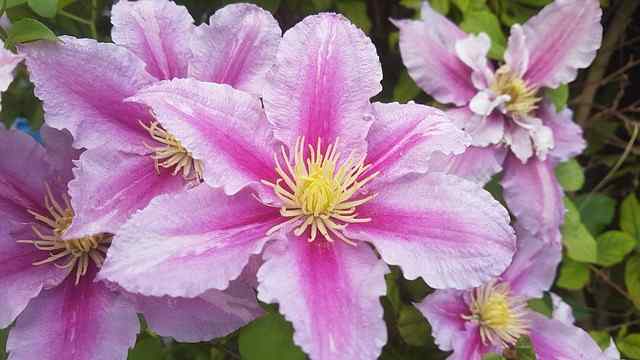
4. Clematis ‘Sweet Summer Love’
Overview: If you’re looking for a clematis that blooms late and continues into autumn, ‘Sweet Summer Love’ is an exceptional choice. This unique hybrid blooms in summer and into the fall, giving you an extended flowering period.
Characteristics: ‘Sweet Summer Love’ is known for its charming clusters of small, star-shaped flowers. The blooms range from lavender to violet and produce an incredible fragrance that draws in pollinators.
Care Tips: This variety appreciates full sun, but like many clematis plants, it benefits from shaded roots. Ensure a well-drained, nutrient-rich soil for optimal growth. Pruning should occur in early spring, allowing for healthy new growth.
5. Clematis ‘Blue Light’
Overview: As a late-blooming variety, ‘Blue Light’ produces flowers beginning in early summer, with peak bloom occurring in late summer and occasionally extending into fall.
Characteristics: This climber features delicate blue flowers that delight the eye with their airy appearance. Each flower can measure approximately 6 inches across, contributing vibrant color wherever it’s planted.
Care Tips: ‘Blue Light’ prefers sunny locations and thrives in moist, well-drained soil. Deadheading spent flowers encourages continuous blooming, and the plant should be pruned back in the spring to encourage new growth.
6. Clematis ‘Nelly Moser’
Overview: While ‘Nelly Moser’ blooms from late spring through summer, it often produces a second round of flowers in late summer and into fall, making it an intriguing option for gardeners seeking extended bloom periods.
Characteristics: The flowers of ‘Nelly Moser’ are quite unique, boasting a blend of pink and white with darker pink stripes. Each blossom can grow up to 7 inches wide, creating a captivating visual impact.
Care Tips: This variety thrives in partial shade, making it ideal for spots where other clematis might struggle. Regular watering and nutrient-rich soil are crucial to its health. Prune in winter or early spring to maintain shape and encourage rejuvenation.
Planting Clematis: Best Practices for All-Day Blooms
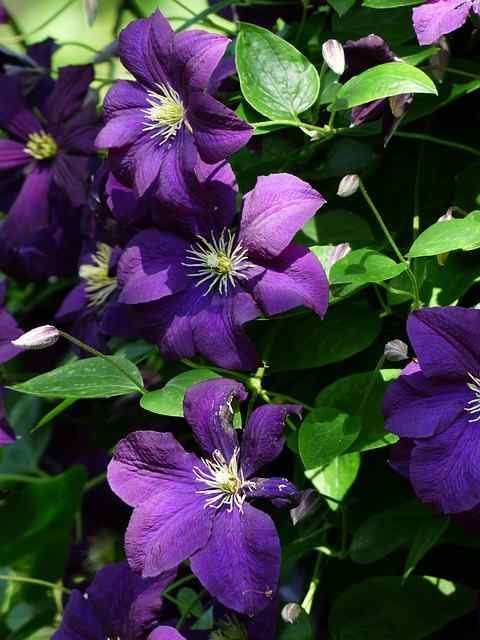
Choosing the Right Location
Selecting the perfect location for planting clematis is critical for healthy growth and abundant blooms. Here are some pointers:
Full Sun to Partial Shade: Most clematis thrive in full sun; however, some varieties prefer dappled shade. Generally, providing 6-8 hours of sunlight will result in more prolific blooms.
Support Systems: Whether you’re growing your clematis on a trellis, fence, or in a container, ensure there’s robust support for the plant to climb. This also allows for better air circulation and sunlight exposure.
Soil Requirements
Clematis enjoy nutrient-rich, well-drained soils. Here are some steps to prepare your soil:
Amend soil with compost to improve drainage and fertility.
Aim for slightly acidic to neutral pH levels (around 6.0 to 7.0).
Mulch around the base of the plant to conserve moisture, suppress weeds, and keep roots cool.
Watering and Fertilizing
Proper watering and nutrition will significantly affect flower production. Here’s how you can support your clematis throughout the growing season:
Water generously during dry spells. Clematis prefers consistent moisture but should not be waterlogged.
Consider using a balanced fertilizer in early spring and again after the initial blooms fade. This practice promotes more robust growth and additional flowering, especially for mid-season and late-blooming varieties.
Pruning Styles
Understanding how and when to prune your clematis is crucial for encouraging healthy blooms. Here’s a brief run-down on the pruning groups:
Group 1: Early bloomers that require minimal pruning. Lightly clean up after blooming.
Group 2: Mid-season bloomers that can be pruned back to buds about 1-2 feet from the ground in late winter or early spring.
Group 3: Late bloomers that should be cut back to ground level in winter or early spring to promote vigorous growth.
Designing with Summer-Blooming Clematis
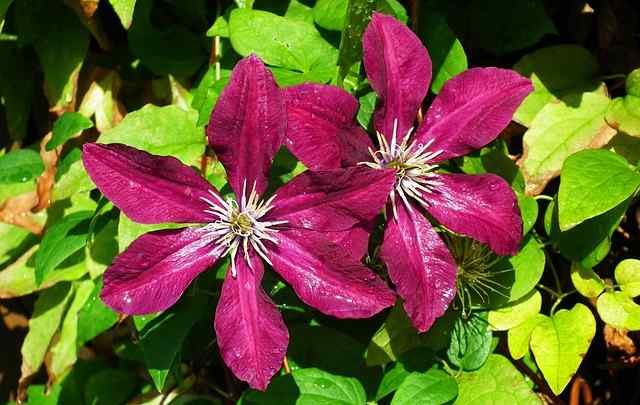
Clematis are incredibly versatile and can be creatively utilized to add height and color to your garden space. Here are some inventive ways to incorporate these spectacular blooms into your landscape:
Vertical Gardens
The climbing nature of clematis makes them perfect candidates for vertical gardens. Pair them with other climbing plants or position them near garden structures. Consider mixing various clematis varieties for a vibrant display, combining early, mid, and late bloomers for continuous color.
Container Gardens
Clematis can also be grown in containers, making them a delightful option for patios or balconies. Select compact varieties or plants that won’t exceed the height of the container. Ensure containers have adequate drainage and fill them with high-quality potting soil.
Ground Cover and Mixed Borders
Clematis can serve as ground cover or be mixed with perennial borders. Layer taller clematis behind shorter perennials to create depth and interest. Their flowers can brighten dull spots in the garden or provide contrast against greens, allowing for stunning visual displays.
Garden Arches and Trellises
Arbors and trellises are a longstanding favorite for clematis cultivation. They draw the eye upward and make a lovely focal point, especially when draped with vibrant blooms. Pairing clematis with other climbing plants, such as roses or jasmine, can create a luxurious look.
Wildlife Gardens
Clematis blooms attract beneficial pollinators, such as bees and butterflies. Planting varieties like ‘Hagley Hybrid’ near pollinator gardens can create vital habitats and enhance biodiversity.
Conclusion
Choosing the right clematis varieties for summer blooms can elevate your garden’s beauty and provide a sustained show-stopping display of color. With attention to location, soil health, watering practices, and creative planting arrangements, you can cultivate a thriving clematis garden. Whether it’s the lush blooms of ‘Jackmanii’, the airy touch of ‘Sweet Summer Love,’ or the rich petals of ‘The President,’ each variety offers unique personality and flair.


